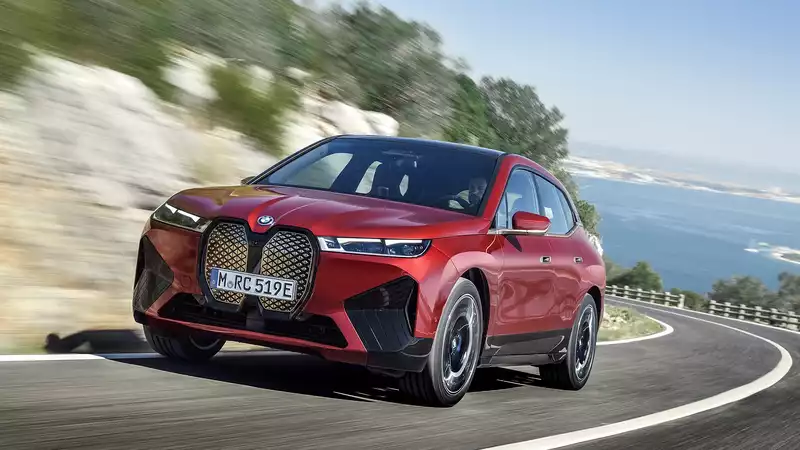Update: We test drove the BMW i4 M50. Despite BMW executives' crazy ideas about maximum range, it remains a great car.
Range is one of the most important characteristics of an electric vehicle. Therefore, it makes sense that automakers would do everything in their power to keep EV charging times as short as possible.
However, there is now beginning to be talk of a range cap, whereby automakers would not increase the range once a certain point is reached. Tesla did it (unofficially), and now BMW may do it too.
And it's a terrible idea: according to Which Car,
BMW i4 project leader David Ferrofino has publicly stated that he has no plans to build an electric car with a range of over 600 km (373 miles). The plug-in hybrid vehicle will also have a range of up to 100 km.
Meanwhile, Elon Musk commented on the extended range when he announced the cancellation of the Tesla Model S Plaid Plus. Musk's official reason for the Plaid Plus cancellation was that the standard Plaid was "better anyway," even though the Plus model is more powerful and offers a 520-mile range.
When asked about range, Mask added that he did not need more than 400 miles of range. He suggested that this break would take place at the same time as the fast charge.
And Mask is correct up to a point. A 400-mile trip at 70 mph would take nearly six hours. Even if one did not need to go to the bathroom in that time, it is still a good idea to pull over and take a break of some sort. That is, of course, if the charging infrastructure is in place.
While EV charging infrastructure has improved over the past decade, chargers are by no means ubiquitous. Compared to gas stations, this is certainly true. Even Tesla's own Supercharger network, while fairly widespread in the US, is not available everywhere. The longer a vehicle's range, the more diversity there is in choosing where to charge.
Time is another factor to consider. Charging an electric car takes longer than filling up a gasoline tank, even with today's ultra-fast fast chargers; even the Tesla Model S Long Range, which is capable of 405 miles of charging, takes more than 30 minutes for a full charge.
Sure, you can add 200 miles of power in just 15 minutes, but on a long enough trip, that just means you have to stop sooner.
This 15-minute measurement also depends on getting the maximum charge rate of 250 kW. Tesla's Supercharger must share power, and the more cars connected, the lower the overall charging speed. This also assumes that the car is not connected to another network, using a $400 Tesla/CHAdeMO charger with a 50 kW speed limit.
Longer range means less frequent stops, which is a big time saver, especially on long drives.
To be fair, 400 miles is a very long way. It is 17 miles from Los Angeles to San Francisco and only 4 miles left from London to Edinburgh. But when you are talking about a spectacularly large country like the United States or Australia, which are 2,800 and 2,485 miles at their widest points, respectively, 400 miles is basically nothing by comparison.
Unfortunately, maximizing range is a balancing act. Cars with longer ranges usually require larger batteries, which increases the price considerably. Automakers also need to design vehicles that are as lightweight and aerodynamic as possible.
Advances in battery technology could provide a major boost here. Earlier this year, Elon Musk gave a Battery Day presentation detailing how Tesla has improved battery chemistry to store (and use) more power in a smaller space.
Smaller batteries are lighter, which would mean less weight to carry without necessarily sacrificing the amount of power available. However, it does not solve the problem of automakers setting arbitrary limits on range.
There will always be a physical limit to the range of electric vehicles, but that is also true of gasoline-powered vehicles. After all, the size of the gas tank is limited, as is the battery. Likewise, price and cost-effectiveness must be considered. A 1,000-mile range is great, but if the price is too high for the average consumer to make it happen, or if the size of the battery is impractical, it is completely meaningless.
My point is that range should not be limited by people or decisions. Increased range is always a good thing, provided it is balanced with the other needs of the driver, and automakers should always strive to drive their cars as far as possible. Whether that be maximizing aerodynamics, improving overall energy efficiency, or developing better batteries.
Hopefully, the fact that, as far as we know, no other automaker has mandated a range cap similar to BMW's suggests that this will not be a long-term problem. Tesla itself has also ignored Musk's claims with its Cybertruck and Roadster, promising ranges of 500 and 620 miles, respectively.
Unfortunately, few electric vehicles are currently capable of achieving 600 km/373 miles, let alone 400 miles. The Tesla Model S and Ford Mustang Mach e can all achieve this distance, and the Tesla Model 3 Long Range comes close at 360 miles; more models like the Rivian R1T and Lucid Air are expected in the near future, but most long-range EVs will be 350 miles, but most long-range EVs seem to run out of steam before they hit the 350-mile mark.
Let's hope automakers continue to push the envelope rather than throw in the towel and declare what they have is good enough.
.









Comments